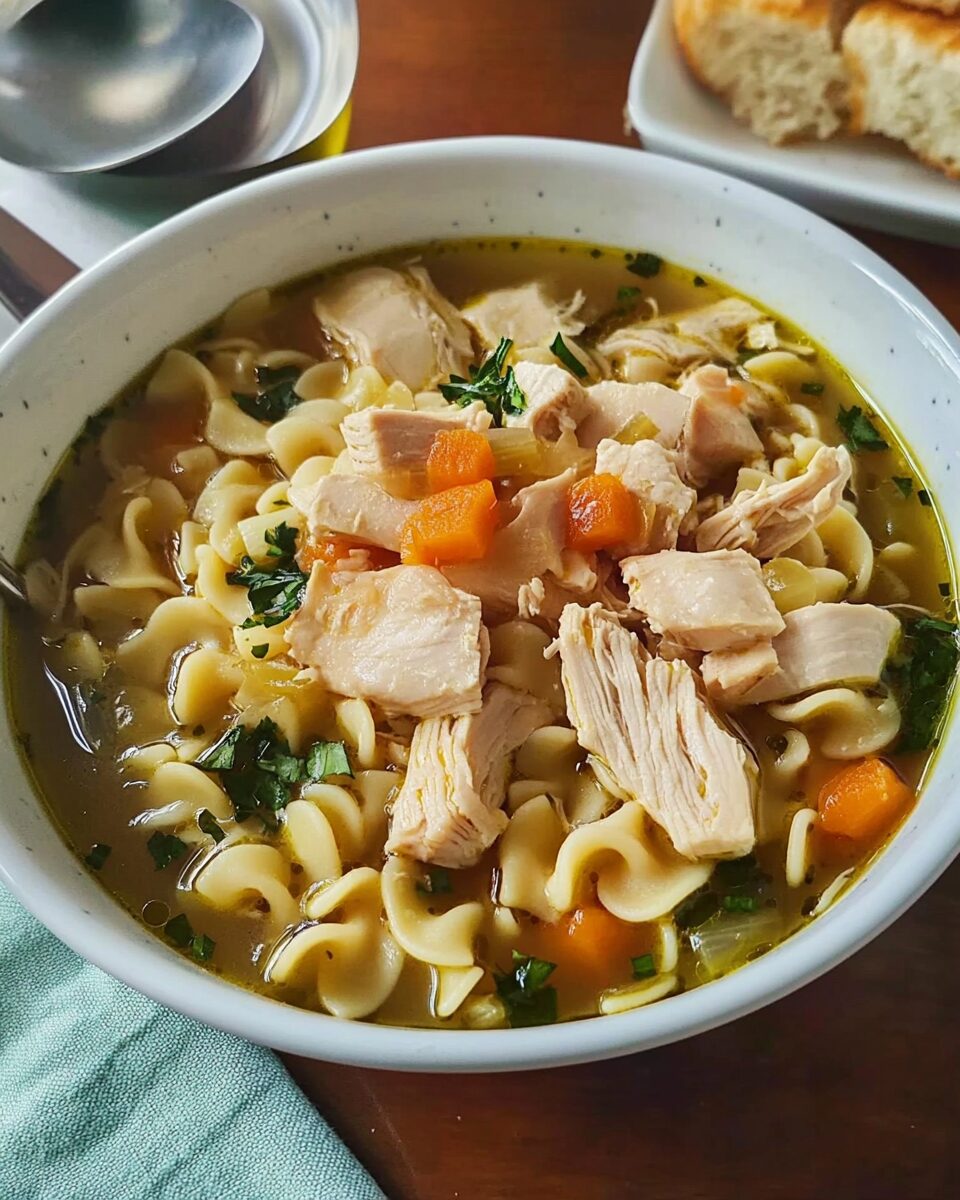Chicken Noodle Soup is a timeless comfort food cherished across cultures for its soothing qualities and hearty flavors. This classic soup combines tender chicken pieces, wholesome vegetables, and soft noodles simmered in a flavorful broth, making it a go-to remedy for cold days or when feeling under the weather.
Full Recipe:
INGREDIENTS
- 1 tablespoon butter
- 1/2 cup chopped onion
- 1/2 cup chopped celery
- 4 (14.5 ounce) cans chicken broth
- 1 (14.5 ounce) can vegetable broth
- 1/2 pound chopped cooked chicken breast
- 1 1/2 cups egg noodles
- 1 cup sliced carrots
- 1/2 teaspoon dried basil
- 1/2 teaspoon dried oregano
- Salt and ground black pepper to taste
DIRECTIONS
- In a large pot over medium heat, melt the butter. Add the onion and celery; cook and stir until just tender, about 5 minutes.
- Pour in chicken and vegetable broths and stir in chicken, noodles, carrots, basil, oregano, salt, and pepper. Bring to a boil, then reduce heat and simmer for 20 minutes before serving.
NUTRITIONAL FACTS (PER SERVING)
- Calories: 150
- Total Fat: 4.4g
- Saturated Fat: 1.4g
- Cholesterol: 45mg
- Sodium: 1,390mg
- Total Carbohydrates: 14.9g
- Dietary Fiber: 1.8g
- Sugars: 3.5g
- Protein: 13.6g
HISTORICAL BACKGROUND
The origins of chicken noodle soup date back thousands of years. Many cultures have created variations of this dish, each incorporating local ingredients and techniques. In ancient China, noodle soups were a common dish made with a variety of broths, vegetables, and meats, including chicken. Similarly, in Jewish cuisine, a version of chicken soup known as “Jewish Penicillin” has been cherished for generations due to its supposed healing properties.
In Europe, chicken-based soups became popular during the Middle Ages when slow-cooked broths were used as a means to extract nutrients from bones and meats. Over time, different countries developed their own versions, with pasta, dumplings, or rice often replacing traditional noodles. The American version of chicken noodle soup, as we know it today, gained popularity in the early 20th century, especially during the Great Depression when affordable and filling meals were in high demand.
CULTURAL SIGNIFICANCE
Chicken noodle soup holds cultural significance in many parts of the world. It is often associated with comfort, home-cooked meals, and recovery from illness. Many people recall childhood memories of being served a bowl of warm chicken noodle soup when they were sick, as it has long been believed to help with colds and flu. In the United States, canned chicken noodle soup became widely available in the 1900s, thanks to the Campbell Soup Company, making it even more accessible to households. Despite the convenience of store-bought options, many people still prefer homemade versions, which allow for fresher ingredients and personalized flavors.
HEALTH BENEFITS OF CHICKEN NOODLE SOUP
Chicken noodle soup is more than just a comforting meal—it also provides numerous health benefits. It is packed with nutrients that support overall wellness, making it a great option for both everyday meals and recovery from illness.
Boosts Immunity
Chicken noodle soup is often recommended when feeling under the weather because of its immune-boosting properties. The warm broth helps soothe sore throats, while the combination of ingredients provides essential vitamins and minerals. Chicken contains amino acids like cysteine, which help thin mucus and ease congestion.
Hydration and Electrolyte Balance
The broth in chicken noodle soup helps keep the body hydrated, which is particularly beneficial when dealing with illness. The sodium and potassium from the soup help replenish electrolytes, preventing dehydration and fatigue.
Rich in Protein
Chicken is an excellent source of lean protein, which is essential for muscle repair, immune function, and overall body maintenance. The protein content in chicken noodle soup makes it a satisfying and nourishing meal.
Supports Digestion
The easy-to-digest ingredients in chicken noodle soup make it gentle on the stomach, making it an excellent option for those recovering from illness or digestive issues. The warmth of the broth can also aid in soothing the digestive tract.
Provides Essential Nutrients
Carrots, celery, and onions commonly found in chicken noodle soup provide essential vitamins such as vitamin A, vitamin C, and antioxidants, which contribute to overall health and wellness. Noodles add carbohydrates, providing quick energy, while herbs like thyme and oregano add additional anti-inflammatory benefits.
VARIATIONS OF CHICKEN NOODLE SOUP
One of the best things about chicken noodle soup is its adaptability. With a few ingredient swaps or additions, the dish can take on different flavors and textures.
Classic Homemade Chicken Noodle Soup
This version is made with a clear broth, shredded chicken, egg noodles, and a simple mix of vegetables and herbs. It is the most traditional and widely recognized preparation.
Creamy Chicken Noodle Soup
A cream-based version of the soup adds richness and depth of flavor. Heavy cream or milk is used to create a thicker, heartier broth, perfect for those who enjoy a more indulgent variation.
Spicy Chicken Noodle Soup
For those who like a little heat, adding chili flakes, cayenne pepper, or jalapeños to the broth can enhance the flavor and provide additional warmth.
Low-Carb or Keto Chicken Noodle Soup
To make a low-carb version, noodles can be substituted with spiralized zucchini, cauliflower rice, or shredded cabbage, creating a lighter but still satisfying soup.
Gluten-Free Chicken Noodle Soup
Using gluten-free pasta or substituting rice for traditional noodles ensures that individuals with gluten sensitivities can still enjoy this comforting dish.
TIPS FOR MAKING THE BEST CHICKEN NOODLE SOUP
To make the perfect bowl of chicken noodle soup, consider the following tips:
- Use Homemade Broth: Making your own broth from chicken bones enhances the flavor and provides additional nutrients. If using store-bought broth, choose a low-sodium option for better control over seasoning.
- Shred the Chicken Properly: Instead of cutting chicken into chunks, shredding it makes the texture more tender and allows the flavors to blend better into the soup.
- Cook Noodles Separately: To prevent mushy noodles, cook them separately and add them to individual servings rather than leaving them in the soup for extended periods.
- Season to Taste: Herbs like thyme, parsley, and bay leaves enhance the soup’s aroma and flavor. Adding a squeeze of lemon juice before serving can also brighten up the dish.
- Store and Reheat Correctly: If storing leftovers, keep the noodles separate from the broth to prevent them from becoming too soft. When reheating, add a splash of water or broth to restore consistency.
STORAGE AND REHEATING
Chicken noodle soup is an excellent meal-prep option and stores well for later use.
- Refrigeration: Store in an airtight container for up to 4 days. Keep noodles separate if possible to maintain texture.
- Freezing: Freeze soup without the noodles for up to 3 months. Thaw overnight in the refrigerator before reheating.
- Reheating: Warm the soup over medium heat on the stovetop or in the microwave, adding extra broth or water if needed.
CONCLUSION
Chicken noodle soup is more than just a meal—it is a symbol of comfort, nourishment, and tradition. Whether made from scratch or using simple shortcuts, this soup remains a favorite for its warmth, flavor, and health benefits. Its rich history, cultural significance, and adaptability make it a dish that can be enjoyed by everyone.






